Wholesale Electricity Market
 Electricity
Electricity
The trading of electricity in a wholesale market is increasingly becoming common in most developed and developing economies. The wholesale electricity market stems from the concept of wholesale trading which relates to the business of selling goods in large quantities and at low prices, typically to be sold by retailers at a profit. Wholesale trading refers to the sale of goods to anyone other than the ultimate consumer.

The wholesale electricity market allows producers, distributors, and consumers of electricity to trade in a rule-based market driven by demand and supply factors. Electricity, though it may appear to be an intangible commodity, is very tangible and has been traded like any other commodity in a market for many years by various economies.

From the above figure, the global electric power generation, transmission, and distribution market was expected to grow from $4,091.77 billion in 2021 to $4,433.15 billion in 2022 at a compounded annual growth rate (CAGR) of 8.3%. The market is expected to reach $5,932.43 billion in 2026 at a CAGR of 7.6%. (Source: Research and Markets, March 17, 2022)
Even though electricity can be generated from various sources, the tradable commodity (the energy measured in kilo-watt hours – (kWh)) is the same though the trading markets, as compared to the trading of other commodities and financial assets, are different. Whilst commodity and financial instruments such as equities, bonds, and other commodities, are traded and delivered at any point in time, electricity is produced and consumed instantly. This peculiar characteristic of electricity needs a deeper understanding, as it is the main difference between wholesale energy markets and traditional financial and/or commodity markets. Even though with current technological advancements in battery storage efficiencies the need to consume electricity instantaneously may change in the future, and further alter the wholesale electricity market as we know it. But until that happens and costs of battery energy storage come down low enough, wholesale energy markets remain a viable means of reducing energy costs and ensuring energy access, particularly in this part of the world.
Electricity, generally, cannot be stored by the producers and consumers, at least not in the commercial quantities needed for commercial or large-scale distribution. Therefore, demand and supply of the commodity needs to be balanced in real-time. It also calls for adequate and varied supply sources to prevent supply shortages. Consumption should also be planned in a way to ensure that what is produced is consumed. These and many other requirements, give rise to different kinds of sub-markets within the electricity markets. Additionally, the financial security of the market is very important, especially in this real-time market. The following paragraphs will discuss electricity and how it is produced and sold. What are the types of markets in the Wholesale Electricity Market? Who are the market participants? How does the market operate? How is the market sustained financially?
What is electricity and how is it produced and supplied?
Electricity is the flow of electrical power or charge. It is a form of energy basic to nature and drives industrial, commercial, and residential activities of all economies. It is a widely used form of energy and can be predominantly produced by a piece of equipment called an electric generator, which converts energy from other sources into electrical energy. The source of energy normally defines the type of electrical energy or electricity. Hydro (water) electricity, Thermal (heat) electricity, Solar (sun) electricity etc. The electrical energy produced by the generator is supplied to the consumer through electric transformers, and conductors that run on electric towers/poles or in underground cables. Electricity is very tangible and regardless of the source from which it is produced, the unit of electricity is the same.
What are the types of markets in the Wholesale Electricity Market?
Due to the peculiar nature of the electric commodity, it is traded in various types of markets. These include:

Who are the market players?
The electricity value chain comprises many industries. Some are directly in the electricity market whilst others are critical to the smooth operation of the market. Those that are directly in the electricity market include electricity generators (public and private generators), electricity transmission companies, electricity distribution companies, and electricity consumers (industrial, commercial, and residential customers). Those that are critical for the operation of the market include suppliers of fuel for electricity generation, financial institutions (including commercial banks), and regulatory agencies in the power sector. Market participants are expected to satisfy specific requirements to be accepted into the market, otherwise there are no barriers to entry and exit of the market.
How does the market operate?
The market operates under a strict set of rules, known as Electricity Market Rules. These rules govern the roles and behavior of all market participants as well as the efficient operation of the power system and the market. Since electricity must be consumed immediately it is produced, there is the need to constantly balance the supply and demand of electricity. This is done by an Independent System Operator (ISO) and Transmission System Operator (TSO) which owns transmission assets. ISO are the administrators of the electricity market rules, and they also ensure that supply and demand are balanced in real-time. ISO and TSO forecast available power generation and demand ahead of time and monitor these plans to ensure that supply and demand is always balanced. In the short term, Market Participants commit to buying and supplying electricity demand at an agreed price, and the ISO/TSO ensures that market participants honor their request by regular communication to power generators and consumers. This is the Energy Market. In balancing the supply and demand, deviations may occur, and the system operator manages these deviations using ancillary services (Ancillary Market) to correct, supply shortfalls, address demand failures and ensure quality of electricity supply. In the long-term, the ISO manages an auction (Capacity Market) to incentivize and ensure that there is adequate generation to meet demand in the future.
How is the market sustained financially?
For the electricity market to be financially efficient, and the credit worthiness of market participants assured, transactions in the market are always backed by financial guarantees and/or commercial banks. Any market participant that is not credit worthy, will not be financially supported, and may have to exit the market. This prevents accumulation of debt in the market.
Why the Need for Reforms in Electricity Markets in Developing Countries?
Electricity supply in most developing countries is done by public utilities. These are normally vertically integrated within the same public utility responsible for production, transmission, and sale of electricity to consumers. Prices are usually regulated and therefore utilities cannot recover their cost of operation, leading to accumulation of debt and inefficient power supply. In the few cases where bilateral contracts exist between suppliers and consumers, payments and reliable supply of power has always been an issue. Operations of public power utilities are normally opaque and transactions in the power sector do not provide value for money. Additionally, there are no clear procurement processes. New generation capacity is not competitively procured, and the electricity supplied is also not competitively priced. Credit Risk is not efficiently allocated or managed, and all risk is ultimately borne by the Government.
The Wholesale Electricity Market environment has successfully addressed the above issues in developed economies, and the few developing countries who have attempted some market reforms have experienced improvements in their power sector.
Are Electricity Market Reforms Relevant in an Era of Energy Transition?
For many jurisdictions that are embarking upon, or in the process of implementing, their energy transition journey towards net-zero carbon emissions particularly in the area of electric power supply, the presence of a wholesale energy market permits the co-existence of a bilateral market that could be used to procure electricity supply resources that are based on renewable technologies. This is because these Variable Renewable Energy (VRE) sources where the predictability of supply of a certain amount of capacity at a predetermined time, does not lend itself easily to the rules of a wholesale energy market. In this instance, the use of a bilateral market. facilitates a scenario in which VREs are the dominant source of electricity supply.
What is required to implement Electricity Wholesale Market?
Starting an electricity wholesale market will require;
i. Functional unbundling of the electricity industry. This requires the physical separation of the power generation, power transmission and power distribution functions. This drives efficiency and transparency of each functional area and allows both the public and private utilities to compete in each of the supply value chains.
ii. Monitoring of standards and efficiency by the regulatory agencies. A Grid Code and Power Market Rules are key requirements for the smooth management and operation of the electricity market.
iii. A centralized power system planning unit is required for short, medium- and long-term power supply and demand projections.
Wholesale Electricity Market experiences in the West Africa sub-region
Although the electricity market in the West Africa sub-region is not well developed, individual countries in the subregion have made some advancement. Though countries such as Ghana, Nigeria, Cote D’Ivoire among a few others have implemented some power sector reforms, their activities in power markets have been limited to internal power sector unbundling and reforms. Trading among countries has been limited to bilateral power exchanges between a few countries (Ghana and Burkina Faso for example), and these have been on-going for more than 40 years. This has been primarily because trading among countries has been limited by lack of power infrastructure to facilitate transactions and non-uniform power trading arrangements. The West Africa Power Pool (WAPP) has over the years been working towards improving power supply and trading between countries, by supporting several power infrastructural projects.
Once the physical infrastructure is in place, the presence of an active regional regulator (in the case of ECOWAS this is the ECOWAS Regional Electricity Regulatory Authority) to harmonize the regulatory frameworks to facilitate cross-border electricity transactions.
In the case of Ghana, there is the existence of over-subscribed capacity which has been expensive for the country. There is also the absence of a good process for procuring capacity for the country. Going forward, Ghana should explore the development of a capacity market that would help to put a process in place for capacity procurement and ultimately reduce the cost of capacity. Ghana also has the option to establish competitive procurement of power which would also help address the issue of expensive capacity. However, the development of a capacity market appears to be a better option than competitive procurement.
Success in the establishment of markets in Ghana would only inure to the facilitation of the set-up of markets within the WAPP region, as buyers would seek to gain access to cheaper sources of generation, utilizing the infrastructure that WAPP has set up over the years.
Do other Markets work in Africa?
The telecom and petroleum sectors have seen marked improvements since markets were introduced years ago. The level of market growth and participation in the market has been remarkable. These sectors in Ghana experienced heavy losses to players in the sector until market regimes were introduced. In the telecom industry, for example, Ghana's mobile market is among the most competitive in Sub-Saharan Africa, with an estimated mobile penetration rate of 127.4% as at September 2022. The Ghana telecom services market was valued at $1.2 billion in 2023. The total telecom service revenue in Ghana is estimated to increase at a CAGR of less than 1%, driven by revenue growth in mobile broadband and fixed broadband segments. The Ghanaian government now benefits from a more rational competitive landscape and a new licensing framework enables mobile virtual network operators (MVNOs) to enter the market. A mobile money interoperability system has been launched in the market, to facilitate mobile money transfers across different networks. The system has simplified money transfer for consumers and has made it more convenient for players in the market.
Importance or Benefits of the Wholesale Electricity Market
A functional Wholesale Electricity market will
· Help achieve and sustain the dual goal of reliable fairly priced power for industrial development and spur economic growth.
· Contribute to the growth of regional electricity trade.
· Ensure that risk will be better allocated to the entities that can best manage risk.
· Provide price discovery and a forward price curve to help with fair valuation and fair prices.
· In the long run, permit generation investors to invest on a merchant basis.
Conclusion
Ghana initiated power sector reforms about 20 years ago with the ultimate objective of liberalizing the power sector and making electricity more available and affordable. In the recent past, indications are that Ghana is progressing activities towards implementing a wholesale electricity market. This initiative is being spearheaded by the Ghana Grid Company Limited, who begun by developing market rules some years ago, and recently has made efforts towards educating key stakeholders on the merits of markets as part of an overall plan to effect wholesale markets in the country. With the benefits seen in the telecommunication market and the petroleum downstream market, similar benefits should be derived in the electricity distribution market once Ghana implements a wholesale electricity market.
CONTACTS






